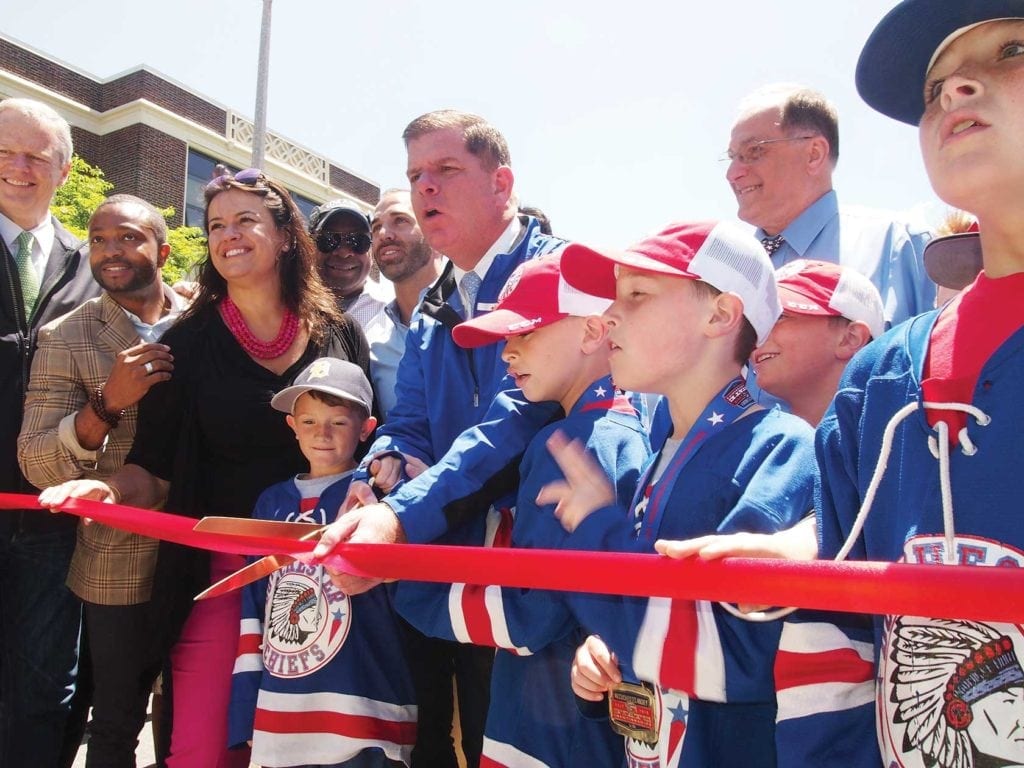
For the better part of the last 22 years, Linda Dorcena Forry has seen the Dorchester Day parade from the front, where the politicians march. First she marched as an aide to former state Rep. Charlotte Golar Richie. Then as 12th Suffolk District representative and finally 1st Suffolk District senator.
Now out of office, Dorcena Forry enjoyed the parade from the sidelines on a stretch of Dorchester Avenue across from St. Gregory’s Church.
“It’s really nice to see the whole parade, because it shows the diversity of Dorchester,” she said.

Ayanna Pressley greet Dorchester residents. Banner Photo
The largest and most diverse neighborhood in Boston, Dorchester has no dearth of civic pride. Dorchester Day, first observed in 1904, commemorates the founding of Dorchester by the Puritans in 1630. The parade continued to grow in popularity as the neighborhood’s Irish American population expanded through most of the 20th century.
In the last 50 years, as Vietnamese, African Americans, Cape Verdeans and Latinos have moved into Dorchester, the parade too has evolved from a predominantly Irish event to a more heterogeneous mashup of cultural expressions.
Headed by the bagpipe-bearing Boston Police Gaelic Column and a the largely Irish-American elected officials who represent the neighborhood in the Legislature’s House and Senate, the parade last Sunday also featured several Latino dance troupes, a rainbow-festooned Dot Out float, a contingent of Cape Verdeans marching with the group CVC Unido, a large contingent marching with the Vietnamese American Community of Massachusetts, and the Dynasty International Caribbean Carnival mas band.

Michael Capuano greet Dorchester residents. Banner Photo
“Thirty years ago, this was mostly a white parade,” said Dynasty bandleader Stephen Coker, riding in a pickup that served as a sound truck for a contingent of a dozen dancers in brightly colored costumes dancing to pulsing soca music.
When blacks first began moving to Dorchester in significant numbers in the 1960s, they settled to the west of the neighborhood along Blue Hill Avenue. As the black population grew in the 1970s, they moved into the Codman Square area, past Washington Street to Bowdoin and into Ashmont.
The integration of the neighborhood in the 1960s, ’70s and ’80s didn’t always go smoothly. Binh Nguyen, who moved into Dorchester in the 1980s, recalls the racial violence he and other political refugees confronted when they moved to the neighborhood.
“It was tough for everybody,” he said. “We had our car windows smashed, our houses vandalized, our children beaten up.”

Vietnamese-American Community of Massachusetts members ride and wave flags in the Dorchester Day Parade. Banner Photo
But the Vietnamese who settled in the neighborhood, many of whom were political refugees, woveinto the fabric of Dorchester, buying homes and opening businesses that revitalized the commercial backbone of the neighborhood along Dorchester Avenue. Today, the Vietnamese community of 20,000 occupies approximately four square miles centered around Fields Corner.
“The neighborhood is very friendly,” Nguyen said, marching in the midst of members of the Vietnamese American Community of Massachusetts, bearing flags of the South Vietnamese republic. “Blacks, whites, everybody has learned how to live in in harmony with other people. We’ve assimilated into American life.”
“You can walk into the Blarney Stone and there are segments from every part of Dorchester, noted state Rep. Dan Hunt, a third-generation Dorchester resident who grew up in St. Anne’s parish in the Neponset section of the neighborhood.

Members of Dynasty International march through Fields Corner. Banner Photo
Now with rising real estate values hitting Dorchester and other Boston neighborhoods, intra-Dorchester rivalries between parishes and sub-neighborhoods have less meaning, Hunt noted.
“You can’t always afford to live where you grew up,” he said. “The South Boston-Dorchester rivalry is gone. People from Savin Hill now live in Neponset. People from Neponset now live in Savin Hill.”
Beyond the social and economic forces that have driven change in the neighborhood, the parade route itself brings the neighborhood together. It follows Dorchester Avenue for nearly three-and-a-half miles from Lower Mills just shy of Milton to Columbia Road just of South Boston, passing sub-districts and parishes with distinct identities.
“You see the entire cross section of Dorchester from Lower Mills to Savin Hill,” said 12th Suffolk Rep. Dan Cullinane, walking at the head of the parade with other elected officials.
And the nature of a parade brings together unlikely themes with its mix of JROTC uniforms, gay pride rainbow outfits, carnival costumes, bagpipes, South Vietnamese uniforms and flags.
“We don’t have many other social spaces that bring us all together like this,” noted Four Corners resident Gibran Rivera, taking in the scene from in front of the Blarney Stone pub with his son and friends.

Gibran Rivera and Liz Miranda. Banner Photo
Politics and parades
Of course the Dorchester Day Parade would not be complete without a healthy dose of campaigning. Leading the parade were Gov. Charlie Baker, Mayor Martin Walsh, U.S. Rep Michael Capuano, City Councilor Michael Flaherty, Suffolk County Sheriff Steve Tompkins, state reps. Russell Holmes, Dan Hunt and Dan Cullinane. Elected officials, marching in their capacity as electeds, are not allowed to march with campaign workers, carry signs or distribute campaign literature.
Marching behind the front lines with tee shirt-clad campaign volunteers were at-Large Councilor Ayanna Pressley, running against Capuano for the 7th District seat; Darren Howell, Liz Miranda and Roy Owens, running for the 5th Suffolk District seat; at-large Councilor Anissa Essaibi George and District 3 Councilor Frank Baker.
All five candidates for the Suffolk County district attorney’s office marched in the parade: 5th Suffolk District Rep. Evandro Carvalho, Shannon McAuliffe, Brian Henning, Rachael Rollins and Linda Champion.

City Councilor Frank Baker marches in Fields Corner. Banner photo
Charlie Baker’s campaign crew, marching well behind the governor and other incumbent electeds, consisted of more than 50 supporters wearing white Baker/Polito tee-shirts.


![Banner [Virtual] Art Gallery](https://baystatebanner.com/wp-content/uploads/2024/04/Cagen-Luse_Men-at-store-e1713991226112-150x150.jpg)



